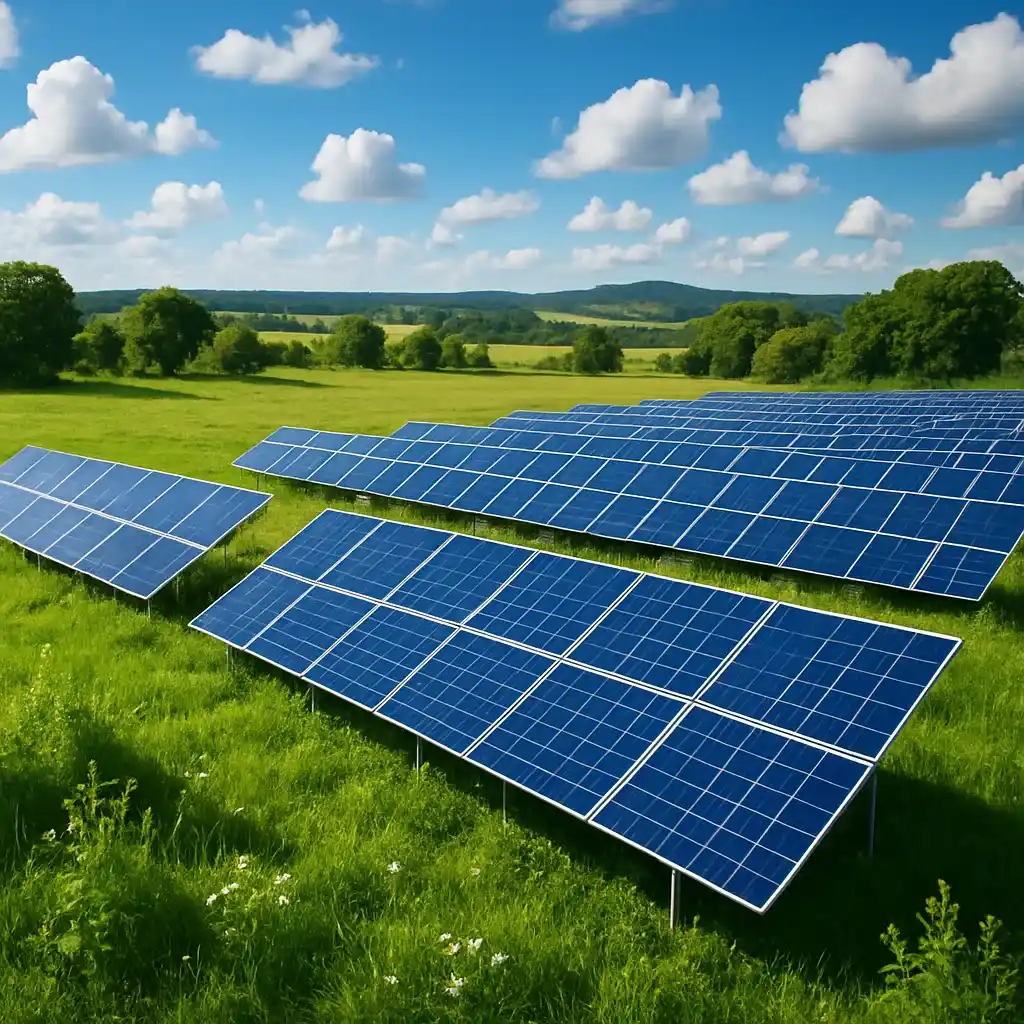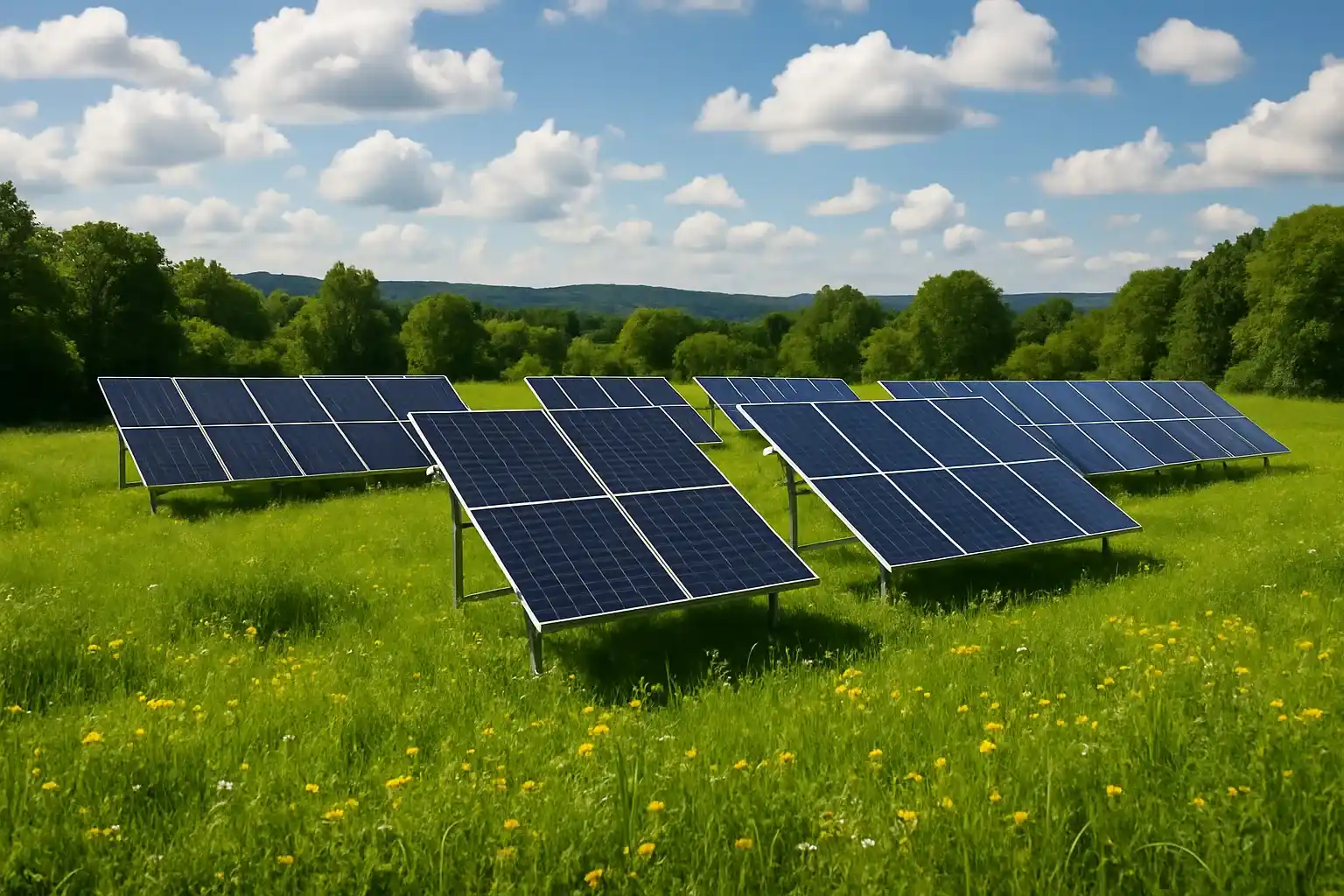- 021-91034194
- Info@pishco.ir
- Tehran, Sa'adat Abad
Home » What is a solar panel and how does it work?
Solar Panel and Its Application: Solar energy is extracted from sunlight. Solar panels receive sunlight and convert photons (energy-carrying particles) into electrical current through a process called the photovoltaic effect. These panels are used in a variety of fields, including providing and managing power in room systems, operating telecommunications equipment, activating sensors, and providing electrical energy in solar systems used for domestic and commercial purposes.
A solar panel is a device that captures sunlight and converts it into electricity. This process is based on a phenomenon called the photovoltaic effect, in which light causes electrons to be released from the surface of a material. The panels are made up of a collection of tiny solar cells, each of which acts as an independent electrical circuit.

Solar panels are a type of technology that captures energy from renewable sources and converts it into electricity. This electricity can be used to charge a variety of electrical circuits. The structure of solar panels consists of several solar cells that are formed from layers of silicon, phosphorus (to create a negative charge), and boron (to create a positive charge).
These panels generate an electric current by receiving photons of sunlight. The energy from the photons causes electrons to be released from their atomic orbits and move in an electric field created by the cells. This field causes the free electrons to be guided in the form of an electric current. This phenomenon is known as the photovoltaic effect.
Many typical homes have enough roof space to install panels that can provide enough electricity for everyday use, while also generating excess power during the day that can be stored for use at night.
Special meters allow owners of these systems to feed excess energy into the grid and receive payment for it if they produce more than needed.
In off-grid systems, equipment such as a battery bank, charge controller, and inverter are key components. Electrical energy is first fed into the controller in the form of direct current and then transferred to the battery bank.
After storing energy in the battery, the inverter steps in and converts direct current into alternating current so that it can be used in devices that operate on AC power.
Based on the inverter power, the size of the solar system is determined to suit the diverse needs of users. The AC power generated can be used in home applications, commercial buildings, vehicles, boats, control systems, mountain huts, telecommunications equipment, and oil and gas well monitoring.
Recommended article: Clean fuel and energy
Solar panels, or photovoltaic cells, absorb energy from sunlight and convert it into electricity using energetic particles of light called photons. Generating electricity is not the only use of these panels, however.
Other functions of solar panels include providing power to control room systems, activating telecommunications equipment, and launching sensors, as well as generating electrical energy for home and commercial use through solar systems.
Before purchasing these panels, it is important to research the different types and choose the model that best suits your needs and circumstances. Below are some of the most common types of solar panels:
This type of panel is made up of silicon crystals that are cut from a large, monolithic block of crystal. The main semiconductor material in these panels is crystalline silicon.
In this type of panel, silicon crystals are the raw material. After melting, these crystals are molded and cut to make monocrystalline solar panels.
Unlike monocrystalline panels, polycrystalline panels are made up of multiple small crystals integrated into each PV solar cell.
In the process of making this model, sheets of polycrystalline silicon are stacked together and melted. Heat-resistant strips are then passed through the molten silicon to form the final structure.
These panels, which are considered the second generation of solar cells, are composed of thin layers of photovoltaic materials placed on substrates such as glass, metal, or plastic.
This model is produced using a smaller amount of silicon, but for this reason, it has a lower efficiency than crystalline types.
This type of panel is made using a cadmium telluride compound and uses photovoltaic technology.
These panels are made by combining four elements: copper, indium, gallium, and selenide, and are mounted on substrates such as glass or plastic. Anodes and cathodes are embedded in the back and front layers to receive electrical energy.
This type of panel is designed to integrate with the architectural components of the building such as the roof, walls, facades and windows. Although it is more expensive, it plays an important role in saving space and optimizing the design.
These panels capture the sun’s thermal energy and use it to heat swimming pool water or household needs. Unlike other models, these panels do not generate electricity.
In the construction of this model, a combination of organic and inorganic conductive materials is used to create photovoltaic layers. This combination increases efficiency and simultaneously utilizes the advantages of both types of semiconductors.

Solar energy is known as one of the prominent and desirable sources of energy with its numerous advantages. Among the most important features of this type of energy are the following:
Renewable: The sun provides an endless source of energy that, unlike fossil resources, is not exhaustible.
Environmental sustainability: The process of utilizing solar energy is carried out without producing pollution and has no negative environmental impacts.
Cost reduction: In recent years, the cost of using this energy has decreased significantly and in many parts of the world, it is considered more affordable than fossil energy.
Reliability: This energy source is available at most times and in all weather conditions and does not require complex backup sources.
Widespread applications of solar energy
Solar energy applications cover a wide range of needs, some of the most important of which are:
Electricity generation: Solar systems can provide the energy needed by homes, businesses, and industries.
Water heating: By utilizing solar energy, water used in residential, commercial, or industrial sectors can be heated.
Drying of agricultural products: This energy is considered a suitable alternative to fossil fuels in drying agricultural products.
Water pumping: Solar systems are able to pump water for irrigation or industrial uses without the need for municipal electricity.
The role of solar panels in providing emergency power
One of the most prominent features of solar panels is their ability to be used in areas that do not have access to the national electricity grid. These panels can provide the necessary electricity in emergency situations or in remote locations without the need for water resources. Among the places where these panels are used are the following:
Medical centers and hospitals
Villas and remote buildings with sloping roofs
Banks, residential complexes and companies
Highways, traffic light poles, lighting poles
Telecommunications towers, parks and public areas
Suggested article: What is green fuel and how is it produced?
The industry standard lifespan of these panels is around 25 to 30 years.
Solar panels can work even on cloudy days, but they can’t produce energy at night. This is due to a scientific phenomenon called the photovoltaic effect, a process in which solar cells are excited by sunlight, causing an electrical current to flow through a circuit.
Rainfall can be beneficial for solar panels. In the process of harnessing solar energy, the cleanliness of the surface of photovoltaic panels plays an important role in their efficiency. Rain naturally washes away dust, pollution, bird droppings, and other nuisance particles from the surface of the panels, allowing the solar panels to absorb more sunlight.
Rainfall can be beneficial for solar panels. In the process of harnessing solar energy, the cleanliness of the surface of photovoltaic panels plays an important role in their efficiency. Rain naturally washes away dust, pollution, bird droppings, and other nuisance particles from the surface of the panels, allowing the solar panels to absorb more sunlight.
لطفا فرم زیر را به دقت پر کنید تا مشاورین ما در اسرع وقت با شما تماس حاصل فرمایند.
Please fill out the form below carefully so that our consultants will contact you as soon as possible.